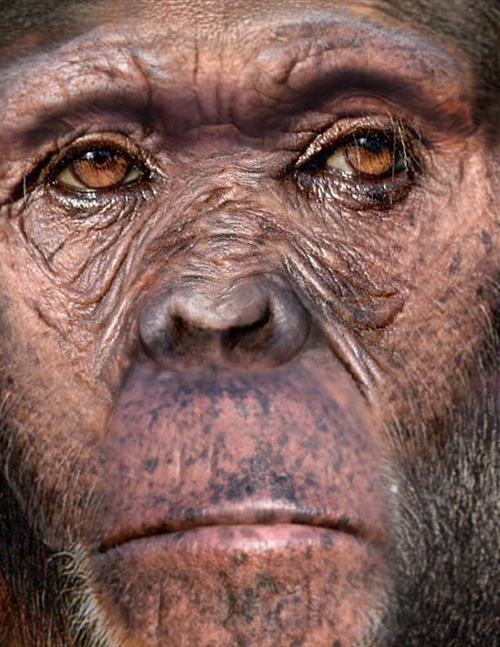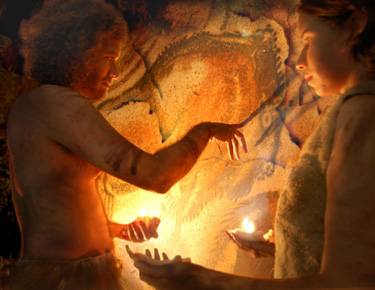The Last Human
A Guide to Twenty-Two Species of Extinct Humans
G. J. Sawyer and Viktor Deak
Preface by Donald C. Johanson
Introduction by Ian Tattersall
Text by Estaban Sarmiento
Afterword by Meave Leakey
“Remarkable in scope and clarity, this stunning collaboration among
scientists, scholars and artists reveals the vast panorama of hominid
evolution. The project began when the Fossil Hominid Reconstruction and
Research Team, led by anthropologist Sawyer and paleoartist Deak, began
reconstructing fossilized skulls and skeletons, using meticulous procedures
of forensic anatomical reconstruction to build three-dimensional models
of contemporary humankind's known predecessors. Paleontological and anatomical
data for each species were combined with anthropological and climatological
research to produce this volume, covering 22 species and 7 million years.
As chapters move chronologically from our most primitive antecedents,
the poorly known "ape-men" of the African Sahel, through more
well-known ancestors, such as the Australopithicines, Homo habilis
and Neanderthals, the data grows in complexity and quantity; happily,
fictional accounts of individual hominids draw readers into each new chapter.
Illustrated with astonishingly life-like portraits of long-gone species,
this volume also includes appendices that describe in detail how those
portraits were achieved. Both inspiring and humbling, this look at humanity's
ancestors the worlds they inhabited, the challenges they faced and the
legacies they left behind is fascinating, informative, and deeply provocative.”
![]() —Publishers Weekly
—Publishers Weekly

Homo rudolfensis.
This book tells the story of human evolution, the epic of
Homo sapiens and its colorful precursors and relatives. The story
begins in Africa, six to seven million years ago, and encompasses twenty
known human species, of which Homo sapiens is the sole survivor.
Illustrated with spectacular, three-dimensional scientific reconstructions
portrayed in their natural habitat developed by a team of physical anthropologists
at the American Museum of Natural History and in concert with experts
from around the world, the book is both a guide to extinct human species
and an astonishing hominid family photo album.
The Last Human presents a comprehensive account of each species with information on its emergence, chronology, geographic range, classification, physiology, lifestyle, habitat, environment, cultural achievements, co-existing species, and possible reasons for extinction. Also included are summaries of fossil discoveries, controversies, and publications. What emerges from the fossil story is a new understanding of Homo sapiens. No longer credible is the notion that our species is the end product of a single lineage, improved over generations by natural selection. Rather, the fossil record shows, we are a species with widely varied precursors, and our family tree is cluttered by many branchings and repeated extinctions.
Photographs of most of the reconstructions that appear in this book are featured in exhibits appearing in the new Hall of Human Origins at the American Museum of Natural History in New York City.
Rights available:
World except U.S., Canada, U.K., and Germany

Female Australopithecus afarensis (Lucy).
Specifications:
256 pages
53 color photographs
8 black and white photographs
24 maps
2 appendices
bibliography
index
Dimensions: 10.6 x 8.1 x 1.1 inches
Shipping Weight: 2.6 pounds
G. J. Sawyer is Senior Scientific Technician at the American Museum
of Natural History.
Viktor Deak is sole proprietor of Studio V.
Donald C. Johanson is Virginia M. Ullman Chair in Human Origins, professor, department of anthropology, and director, Institute of Human Origins, at Arizona State University.
Ian Tattersall is Curator, Division of Anthropology, at the American Museum of Natural History.
Meave Leakey is research associate, National Museums of Kenya, adjunct professor, Stony Brook University, New York, and Explorer-in-Residence, National Geographic Society.
Reviews
“As paleoanthropologist Ian Tattersall points out in his introduction
to this marvelous new book on our ancestors, we Homo sapiens find
ourselves in the unusual situation of being alone on the planet as the
sole surviving hominid. For most of the history of the hominid lineage,
the world was home to coexisting prehumans and humans. From paleontological
and anthropological data previously available only in scientific publications,
the authors have created an accessible field guide to our extinct cousins.
Beginning each section with a short slice-of-life story about the species
in question brings that hominid to life, with the supportive scientific
evidence following. Skulls are often the most common or complete fossil
evidence, so they are well described, along with other remains (bones
and/or tools), fossil sites, other associated animals, the probable climate,
and a discussion of the species' classification. Striking illustrations
accompany the write-ups and breathe life into dry fossil bones. This very
current book explains the science as it now stands and is a must-buy for
all libraries.”
![]() —Booklist
—Booklist

Homo sapiens (Cro-magnon).
Click here to return to book.